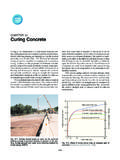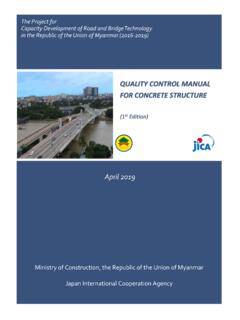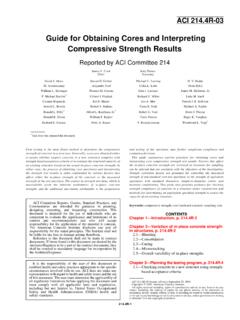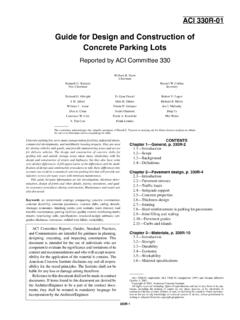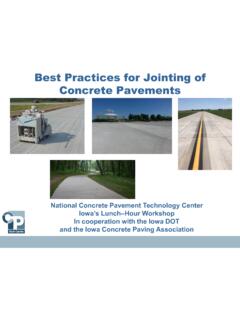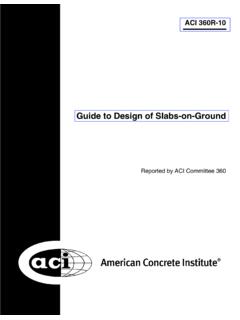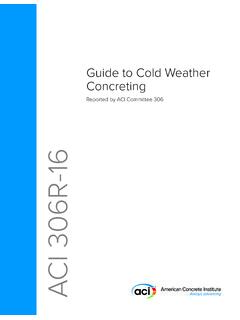Transcription of CONCRETE BASICS A Guide to Concrete Practice
1 CONCRETE BASICS A Guide to CONCRETE PracticeCONTENTSF orewordpage 2 chapter 1 CONCRETE Materialspages 3 5 chapter 2 CONCRETE Propertiespages 6 9 chapter 3 CONCRETE Testingpages 10 13 chapter 4 Ordering Concretepage 14 chapter 5 Proportioning and Mixing Concretepages 15 16 chapter 6 Planning and Site Preparationpages 17 19 chapter 7 Transporting and Placing Concretepages 20 22 chapter 8 Compacting Concretepages 23 25 chapter 9 Finishing Concretepages 26 27 chapter 10 curing Concretepages 28 30 chapter 11 Joints in Concretepages 31 33 chapter 12 Hot and Cold Weather Concretingpages 34 35 chapter 13 Surface Finishes on Concretepages 36 39 chapter 14 Defects in Concretepages 40 43 chapter 15 Removing Stains from Concretepages 44 46 chapter 16 Cracking in Concretepages 47 49 chapter 17 Reinforced Concretepages 50 52 chapter 18 Formworkpages 53 54 MORE Informationpages 55 56 Cement CONCRETE & Aggregates Australia1 CONCRETE BasicsContents1 Cement CONCRETE & Aggregates AustraliaCement CONCRETE & Aggregates Australia is a not for profit organisationsponsored by the cement CONCRETE and aggregate industries in Australia to provide information on the many uses of cement and CONCRETE .
2 This publication is produced by CCAA for that purpose. Since the informationprovided is intended for general guidance only and in no way replaces theservices of professional consultants on particular projects, no legal liabilitycan be accepted by CCAA for its Published July 1991 Second Edition 1992 Third Edition 1994 Fourth Edition 1996 Fifth Edition October 2002 Sixth Edition August 2004 ForewordConcrete is widely used in domestic, commercial, recreational, rural andeducational around the world rely on CONCRETE as a safe, strong and simplebuilding material. It is used in all types of construction; from domestic work tomulti-storey office blocks and shopping the common usage of CONCRETE , few people are aware of theconsiderations involved in designing strong, durable, high quality Basicsaims to provide a clear, concise explanation of all aspects ofmaking quality CONCRETE ; from the Materials and Properties involved throughPlanning, Preparation, Finishing and Basicsaddresses the needs of unskilled and semi-skilled personsundertaking general concreting projects including home and handyman Basicsalso assists owner builders in the supervision of aims to develop an understanding of highly technical terms through cleardefinition accompanied by simple illustrations.
3 A general understanding of theseterms will help to facilitate communication within the building Basicswill help to generate a higher standard of workmanship on-siteand facilitate better communication among construction workers, builders,engineers, building surveyors, architects and anyone interested in understandingthe processes involved in making quality CONCRETE & Aggregates Australia2 CONTENTSC oncrete BasicsForeword2 chapter 1 CONCRETE MaterialsCONCRETEis made by mixing:CEMENTWATERCOARSE AND FINE AGGREGATESADMIXTURES (if required).The aim is to mix these materials in measured amounts to make CONCRETE that is easy to:TRANSPORTPLACECOMPACTFINISHand which will set, and harden, to give a strong and durable amount of each material (ie cement, water and aggregates) affects the properties of hardened CONCRETE .
4 (SeeCHAPTER 2 CONCRETE Properties)CEMENTThe cement powder, when mixed with water, forms a paste acts like glue and holds or bonds the aggregates are six majortypes of cement sold in Australia:Type GP(General Purpose Portland cement)Type GB(General Purpose Blended Cement)Type HE(High Early Strength cement)Type LH(Low Heat cement)Type SR(Sulfate Resisting cement)Type SL(Shrinkage Limited cement)Each type of cement will produce CONCRETE with different most common types of cement are Type GP and Type cements contain portland cement and more than 5% ofeither fly ash, ground slag, silica fume, or a combination of CONCRETE & Aggregates Australia3 CONTENTSC oncrete BasicsConcrete Materials3 AGGREGATES65 80% of mix volumeWATERCEMENTSTORAGEC ement should be stored off the ground in awell-aired, clean, dry the cement bags in plastic sheets gives extraprotection,Bulk cement will normally be stored in are of two basic types:COARSE.
5 Crushed rock, gravel or : fine and coarse sands and crusher should be concreting sand and not brickies sand or plasterers should be:STRONG and HARD A stronger, harder aggregate will give a stronger finalconcrete. Never use a crumble or flakey rock like to stand up to wear and tear and INACTIVE so the aggregates don t react with the Dirt or clay sticking to the aggregates will weaken the bond between paste and Aggregates should range in size so that they fit together gives a stronger and denser aggregates give a moreworkable mix. Angular aggregates make CONCRETE harder to place, work and compact, but can make CONCRETE Aggregates should be stored where they will stay clean, separated from othermaterials and dry. If the aggregates are very wet use less water in the Water is mixed with the cement powder to form a paste whichholds the aggregates together like must be clean, fresh and free from any dirt, unwanted chemicals orrubbish that may affect CONCRETE plants now use recycled CONCRETE & Aggregates Australia4 CONTENTSC oncrete BasicsConcrete Materials4 Always check bore water before t use sea water as it may rust the steelreinforcement in the are mixed into the CONCRETE to change or alter its properties, iethe time CONCRETE takes to set and harden, or its THE PROCESS WORKSM easured amounts of the coarse and fine aggregates aremixed measured amount of cement is added and mixed water is added to make the mix workable.
6 All the materials are then mixedtogether well. The cement powder and water form a paste which bonds the aggregatestogether like CONCRETE & Aggregates Australia5 CONTENTSC oncrete BasicsConcrete Materials5 chapter 2 CONCRETE PropertiesThe Properties of CONCRETE are its characteristics or basic four main properties of CONCRETE are:WORKABILITYCOHESIVENESSSTRENGTH andDURABILITYC oncrete has three different states:PLASTICSETTINGHARDENINGIn each state it has different STATESP lastic State When the CONCRETE is first mixed it is like 'bread dough'.It is soft and can be worked or moulded into different shapes. In thisstate CONCRETE is called PLASTIC. CONCRETE is plastic during placingand most important properties of plastic CONCRETE are workability and worker will sink into plastic State CONCRETE then begins to stiffen.
7 The stiffeningof CONCRETE , when it is no longer soft, is called takes place after compaction and during that is sloppy or wet may be easy to place but willbe more difficult to worker leaves footprints in setting State After CONCRETE has set it begins to gain strength and harden. The properties of hardenedconcrete are strength and CONCRETE will have no footprints on it if walked CONCRETE & Aggregates Australia6 CONTENTSC oncrete BasicsConcrete Properties6 Workability Workability means how easy it is to:PLACEHANDLECOMPACT andFINISH a CONCRETE that is stiff or dry may be difficult to Handle, Place, Compact, and Finish and, ifnot constructed properly, will not be as strong or durable when finally hardened. A slumptest can be used to measure the workability of 3 CONCRETE TestingWorkability is affected by:THE AMOUNT OF CEMENT PASTEThe cement paste is the soft or liquid part of the CONCRETE mix.
8 The more pastemixed with the coarse and fine aggregates, the more workable a AGGREGATE GRADINGSeeAggregate Grading under , smooth, rounded aggregates improve the workability of a m a k e a more workable mix:Add more CEMENT WELL GRADED an try to make a mixture more workable by justadding more water because this lowers the strengthand durability of CONCRETE & Aggregates Australia7 CONTENTSC oncrete BasicsConcrete Properties7 Strength and DurabilityWell made CONCRETE is a naturally strong and durable is DENSE, reasonably WATERTIGHT, able to resist changes in TEMPERATURE, as wellas wear and tear from and Durability are affected by the density of the CONCRETE . Denser CONCRETE ismore watertight (or less permeable). CONCRETE durability INCREASES with made CONCRETE is very important to protect the steel in reinforced 17 Reinforced ConcreteStrength of CONCRETE in the hardened state is usuallymeasured by the COMPRESSIVE STRENGTH using the Compression chapter 3 CONCRETE TestingStrength and Durability are affected by:COMPACTION Compaction is removing the air from CONCRETE .
9 Proper compactionresults in CONCRETE with an increased density which is stronger and more 8 Compacting ConcreteCURING curing is keeping CONCRETE damp for a period, to allow it to reach maximumstrength. Longer curing will give more durable 10 curing ConcreteWEATHER Warmer weather will cause CONCRETE to have a higher early 12 Hot and Cold Weather ConcretingTYPE OF CEMENT Different types of cement will affect CONCRETE properties: ie howquickly or slowly CONCRETE gains WATER TO CEMENT RATIO Too much water and not enough cement meansconcrete will be weaker and less water to cement ratio (W/C) isthe weight of the water divided bythe weight of litres W/C = ie = kgThe lower the ratio, the strongerthe CONCRETE & Aggregates Australia8 CONTENTSC oncrete BasicsConcrete Properties8 Note: 1 litre of water weighs 1 is how well CONCRETE HOLDS TOGETHER when is affected by.
10 THE AGGREGATE GRADINGG raded Aggregate means that there is a range of size of aggregates, from largerocks to small sands. Well-graded aggregates give a more cohesive mix, too muchcoarse aggregate gives a boney CONTENTA mix that has too much water will not be cohesive and may separate and CONCRETE & Aggregates Australia9 CONTENTSC oncrete BasicsConcrete Properties9 chapter 3 CONCRETE TestingThere are two main tests to be done on CONCRETE :The SLUMP SLUMP test shows the WORKABILITY of measures how easy the CONCRETE is to place, handleand 2 CONCRETE PropertiesThe COMPRESSION COMPRESSION test shows the best possible strengthconcrete can reach in perfect compression test measures CONCRETE strength in thehardened should always be done carefully.
